In the echoes of military barracks, there lingers a term that, for many, conjures up more than its fair share of controversies – “barracks bunny.” Portrayed often in hushed tones and accompanied by the glint of rumor, the barracks bunny is someone, typically a woman, known for sleeping with soldiers during those long off-duty hours, particularly on restive Friday and Saturday nights. They’re not actual bunnies, that much is for sure, but that’s the moniker that sticks.
The military service is a world unto itself, a microcosm breeding its own culture, complete with a vernacular rich in colorful epithets. In this article, we’ve set out to pull back the curtain and explore the Barracks Bunny phenomenon, delving into its hidden depths through a tapestry of firsthand accounts, pointed data analysis, and scholarly interviews.
Unraveling the Mysteries Behind the Barracks Bunny Phenomenon
Historical Context of the Barracks Bunny Label in the Military
The barracks bunny term has been hopping through the lexicon of military personnel for years, with its origin story as veiled as the subject it describes. It is deeply rooted in military parlance, with male and female soldiers alike potentially slipping into this stereotype. However, yesterday’s whispers are today’s open conversations, as shifts in policy and growing gender equality awareness foster a new understanding of fraternization and gender dynamics within the armed services.
The Day-to-Day Reality of a Barracks Bunny: True Stories
These aren’t just scandalous whispers behind closed doors; they’re lived experiences with real emotional tolls. Individuals who’ve been stamped with the barracks bunny label have shared their stories – tales of being confined to a stereotype, undermining professionalism, and often, leading to psychological stress and ostracism.
Analyzing the Barracks Bunny Stigma Through a Gender Lens
Diving into the barracks bunny narrative unveils a stark lens of gender inequality, holding up a mirror to societal biases at large. Gender studies experts and military sociologists chime in, arguing that while the stigma clings tenaciously to female service members, it reflects and perpetuates broader gender imbalances.
Defense Policies and the Barracks Bunny: Addressing the Underlying Issues
Defense policies haven’t always helped the cause. Inadvertently, certain protocols and guidelines may have stoked the flames of the barracks bunny narrative. Fortunately, the military hasn’t turned a blind eye, and there have been concentrated efforts to address issues of fraternization, harassment, and the unequal treatment of women in service. Initiatives promoting cultural change are paving the way for that.
Beyond the Barracks: The Role of Media and Pop Culture in Perpetuating the Archetype
From the brash frontlines of epic war movies to the gritty realism of military dramas, pop culture has played a significant role in both perpetuating and challenging the barracks bunny archetype. Women in uniform have often been boxed into this stereotype by the very stories that claim to honor them. However, not all depictions are stuck in the mud. Some break the mold, offering new, empowered narratives that both reflect and inspire the real-world changes occurring in military culture.
The Voice of the Barracks Bunny: From Stereotype to Agent of Change
But what happens when those labeled as a barracks bunny take back the power? Some are transforming an insult into a badge of honor, using their experiences to push for a better military, forging support networks, and advocacy groups turning what was once a stigmatizing term into a clarion call for change.
Conclusion: The Path Forward for Military Culture and Inclusivity
The barracks bunny saga is complex and deeply human, reflecting issues that extend far beyond the military’s perimeter. What we need now is a sustained and systemic effort—a crusade for a military ecosystem that respects and includes all, without the shadow of archaic labels. Through dialogue, education, and ongoing policy refinement, there lies the promise of newfound respect and dignity for all service members, irrespective of gender or reputation.
Now, let’s dive in deeper, take a closer look – and, as promised, unveil the hidden secrets of the barracks bunny phenomenon.
| Category | Details |
| Definition | A derogatory slang term used informally within the military community to refer to individuals who are perceived to be sexually promiscuous within the context of a military barracks. |
| Common Usage | Referred to individuals (often female but can be male) who are rumored to engage in sexual relationships with multiple military personnel. |
| Origin | Military slang; the exact origins are unclear but the term reflects a stigmatizing stereotype. |
| Gender | Primarily associated with females, but the behavior can pertain to any gender. |
| Location | Typically found in military barracks, where unmarried military personnel reside. |
| Associated Terms | Barracks rats, referring generally to military personnel living in the barracks and engaging in promiscuous behavior. “Hopping from room to room” is another colloquial expression used. |
| Behavioral Impact | Can contribute to a harmful environment; perpetuate stereotypes and impact morale and cohesion within military units. |
| Consequences | Social stigma; potential impact on careers, mental health, and interpersonal relationships. Can lead to issues such as harassment or abuse. |
| Military Response | Various branches of the military may have policies to maintain professional conduct and uphold standards that discourage such behavior. |
| Notable Discussion | The term is used in military-based discussions as a point of addressing the broader topics of sexuality, conduct, privacy, and respect within the armed forces. |
Unraveling the Mysteries Behind the Barracks Bunny Phenomenon
Not so long ago, the term ‘barracks bunny’ operated largely in the shadows of military jargon. It’s a label usually, though not exclusively, cast upon women, and speaks volumes about military culture – a culture that, for many, remains as enigmatic as it is entrenched. So, what’s behind this term that’s as controversial as it is common in military vernacular? Let’s hop in and see what stories lay camouflaged within the barracks’ walls.
Historical Context of the Barracks Bunny Label in the Military
The moniker “barracks bunny” might come across as a contemporary creation, but truth be told, it’s been around the block – or the barracks corridor, so to speak – for quite some time. The origins of the term are somewhat murky, a lexicon of military-speak that has morphed over the years, with each iteration capturing the shifting dynamics of its era.
In the past, the barracks bunny could be a nebulous villain hidden in the ranks, often subjected to hushed gossip and the occasional scornful finger-pointing. Yet, as we knit through time’s fabric, today’s armed services no longer quietly abide by such unspoken rules. With changing policies and stories brought to life by the bold voices of those on the inside, perceptions have been compelled into transformation.
The changes in attitudes toward fraternization and gender dynamics are not trivial. Soldiers once living under unwritten codes of conduct now navigate new protocols designed to attenuate the gendered disparity that the barracks bunny label has come to embody. It’s a martial landscape in flux, progressively widening the trench between outdated stereotypes and modern inclusivity.
The Day-to-Day Reality of a Barracks Bunny: True Stories
Behind the barracks’ closed doors, the reality for those dubbed as bunnies is a daily gauntlet – a mix of judgment and jest that often leaves a sour aftertaste. Here, we venture beyond mere anecdote, bringing forth the anonymous confessions of servicewomen and men, whose stories reveal a jarring emotional riptide flowing beneath the barracks bunny label.
For those who’ve worn the bunny badge, whether earned or unjustly bestowed, it can feel like a scarlet letter seared into military fatigues. One servicewoman recounts her struggle to retain dignity amidst the ongoing hearsay, lamenting how the label chipped away at her professional reputation, setting the stage for discrimination and self-doubt.
Another soldier paints a picture of isolation, where camaraderie turns to suspicion, and unity gives way to segregation. The barracks bunny stigma does more than label; it alienates, creating an undercurrent that can sweep away morale and erode the integrity of military cohesion.
These narratives, though told through the filter of anonymity, are stark depictions of the day-to-day grind where perception often trumps reality, and where living under a stereotype is a taxing role that none auditioned for.
Analyzing the Barracks Bunny Stigma Through a Gender Lens
When you break it down, the barracks bunny tag isn’t just a fleeting insult – it’s a symptom of a larger societal malaise reflected in the gendered fissures within military ranks. To uncrate the complexities of this term is to unpack a world laden with inequality and bias; a task that gender studies professionals and military sociologists undertake with fervent scrutiny.
What does it say about our culture when a woman’s reputation can be tarnished by a label indicating promiscuity, while her male counterparts often escape unscathed? It speaks to an imbalance that resonates far beyond the barracks, echoing in workplaces and institutions worldwide. Gender-specific challenges in the armed forces are magnified under the microscope of such stigma, revealing the undercurrents of double standards and the imperative for a recalibration of gender dynamics.
Defense Policies and the Barracks Bunny: Addressing the Underlying Issues
Digging through the defense policies offers a revealing insight into how some military procedures may inadvertently contribute to the perpetuation of the barracks bunny narrative. Various branches of the armed forces have begun to confront this issue head-on, striving to revise and enforce regulations to ensure a more equitable environment.
Efforts have been made to explicitly address fraternization, harassment, and the unfair treatment of women in uniform. Programs designed to educate and change the intrinsic culture are currently at the forefront of the military’s push towards progress, laying a foundation for a future untainted by the prejudices of the past.
Among these are initiatives that lean into the support for servicewomen, offering resources such as Aeroflow breast pump provisions to ease the challenges of motherhood in service. This form of support plays a pivotal role in displaying an institutional commitment to the well-being and inclusivity of all service members.
Beyond the Barracks: The Role of Media and Pop Culture in Perpetuating the Archetype
As soldiers march on the silver screen and combat tales unfurl in bestsellers, the role of media and pop culture in shaping and solidifying the barracks bunny image is as indictable as it is influential. From top-grossing war epics to gritty serialized dramas, the portrayal of military women often flirts with the barracks bunny trope, perpetuating a narrative that’s threaded through the public psyche.
Yet, not every script or storyline is an echo of stale stereotypes. Some narratives are more akin to the best Leonardo dicaprio Movies, which shake off the dust of convention and redefine characters with depth and complexity. Such stories not only entertain but educate, influencing public perception and, in turn, the lived experiences of military personnel. They offer a glimpse of servicewomen rendered not as one-dimensional bunnies but as multifaceted, strong individuals, fully vested in the same honor and grit attributed to their male counterparts.
Beyond mere entertainment, these representations serve as a beacon for change, lighting the way for a more nuanced understanding of gender roles within the military framework. Progressive tales of valor and virtue telegraph a message of hope and transformation, challenging the audience to re-evaluate their preconceptions and embrace a new paradigm of representation.
The Voice of the Barracks Bunny: From Stereotype to Agent of Change
And what becomes of the women who once felt shackled by the barracks bunny stigma? Some are no longer content to let the term define them. Instead, they’re flipping the script, seizing the so-called insult and using it as a springboard for advocacy and reform.
Leading by example, these individuals are changing the conversation, transforming the narrative from one of defaming gossip to a rallying cry of empowerment. Support groups and peer networks arise from the need of those affected to rewrite their stories, advocating for respect, reform, and recognition within the military milieu.
Their efforts are highlighted not merely as anecdotes of survival but as testimonies of resilience. They shine a light on the power of reclaiming agency and crafting new definitions of identity that defy limitations and champion inclusivity.
It’s in these voices that the true transformation of the barracks bunny label from a stereotype to a symbol of change becomes visible. It’s a potent reminder that the path forward requires not only the reform of institutional policies and practices but also the reshaping of cultural narratives and the empowering of those once ostracized.
Conclusion: The Path Forward for Military Culture and Inclusivity
The mosaic of stories and analyses paints a comprehensive portrait of the barracks bunny phenomenon—one that’s riddled with complexity and steeped in the broader issues of military culture. It’s a term that, for better or worse, has etched itself into the annals of military lore, but that now faces the scrutinizing gaze of modern reform.
The path forward for military culture demands a sharpened focus on inclusivity and respect, a promise to treat all service members with the dignity they deserve, regardless of gender or judgment. It’s a call for an evolution that looks beyond archaic labels towards a future that honors the valor and sacrifice of all those in uniform.
This isn’t merely a conversation reserved for the confines of mess halls or faded pages of military strategy. It’s a pressing, public issue that invites continued dialogue, persistent education, and relentless policy revision. It’s a call to action to ensure that the tails of the barracks bunny hop into the annals of history, making way for an era where every soldier can stand tall, unshadowed by the weight of outdated stigmas.
Stepping out of this deep dive into the barracks bunny’s world, we emerge more informed and empowered to contribute to this necessary shift in military culture. Let us continue the conversation, advocating for the changes necessary to build a military that truly reflects the values of honor, courage, and equality it so ardently defends.
The Enigma of the Barracks Bunny
Picture this: you’re scrolling through the latest movie gossip, and the term ‘barracks bunny’ hops right off the page. Have you ever wondered where it comes from or what secrets lurk behind it? Well, hold onto your hats because we’re diving deep into the rabbit hole!
The Origin Story
Now, don’t hop to conclusions thinking ‘barracks bunny’ refers to some cute, fluffy creature. Nope, in military jargon, a ‘barracks bunny’ can often be someone who’s become rather, well, familiar with the barracks – and not because they love the canteen food. You see, in some circles, it’s slang for a person who has a thing for soldiers and isn’t exactly shy about it. But let’s not turn into judgmental Josies; after all, all Girls are The same just doesn’t cut it as an excuse, folks.
The Mysterious Allure
You’ve got to wonder, what’s the attraction to the barracks? Maybe it’s the buzz of bravery or the uniformed allure that’s as snug as a sherpa lined jacket on a chilly evening. But remember, a ‘barracks bunny’ isn’t a label to be taken lightly or thrown around like loose change.
Financial Facts VS Fiction
Now, let’s get down to brass tacks. Rumor has it some ‘barracks bunnies’ are after more than just a salute and a smooch – they’re hunting for that lifestyle with the hefty perks. I mean, who wouldn’t want to snag someone with the financial stability of a credit cards With $ 10000 limit Guaranteed approval kind of lifestyle? But let’s not get ahead of ourselves; not everyone’s after a payday.
Insurance Against Heartbreak?
Talk about a policy! We hear the grapevine buzz about ‘barracks bunnies’ looking for something as secure as the average house insurance cost in a relationship. It’s a crazy world out there, can you really blame someone for wanting a little security? But love isn’t a policy you can quantify, and hearts can be as hard to navigate as a minefield.
The Bunny Spectrum
Hold the phone, did you really think all ‘barracks bunnies’ were cut from the same cloth? As our friends at Bitches Girls would say – there’s a whole spectrum of personalities hopping about in the barracks scene. It’s like a kaleidoscope of intentions and desires, from the innocent to the, well, less so.
From Bunny to ‘Belico’
Here’s a plot twist: some ‘barracks bunnies’ are going full “belico” – that’s military talk for warrior. They’re trading their bunny reputation for boots and fatigues, and enlisting themselves! Talk about turning the tables; from seeking soldiers to being the one who salutes.
The Bottom Line
Let’s cut the fluff; being tagged a ‘barracks bunny’ can be a badge worn with mixed feelings. It’s a world overshadowed by stereotypes and whispered rumors, but shimmering with untold stories. And while we’ve had our fun uncovering the secrets, let’s not forget the old adage: Every bunny’s got their own tale.
Remember, this isn’t about pointing fingers or labeling – it’s about peeking through the keyhole into a world that’s as misunderstood as it is talked about. Whether you’re a certified ‘barracks bunny’, a staunch defender, or just here for the juicy tidbits, it’s always best to hop to your own beat.
What does barracks bunny mean?
– Ever heard someone called a “barracks bunny” around military digs? No need for confusion—it’s not a cute critter we’re talking about. Dated January 4, 2020, the term describes someone, often a female, known for sleeping with soldiers in their off-hours. Picture them bouncing around mostly on Friday and Saturday nights. But let’s be clear—they’re not actually fluffy bunnies; that’s just the barracks banter for you.
What is the difference between barracks rat and barracks bunny?
– Barracks rat or barracks bunny—seems interchangeable, but there’s a twist. Barracks rats and barracks bunnies share a similar rep for being friendly with the troops in those military living quarters. The main difference? Barracks bunnies are typically residents of the barracks, part of the unit, and they’ve got their own space, you know, at the end of the hallway.
Can a male be a barracks bunny?
– Well, well, well, here’s where stereotypes get busted! Although often labeled as females, males in fatigues can totally earn the title of a barracks bunny, too. It’s all about the behavior, not the gender. So yep, men can—and do—get around in the barracks scene as well.
Why do barrack bunnies exist?
– So, why the heck do barracks bunnies even exist? Get this: Some folks just find love (or something like it) in a military-clad package more than once. I’m not kidding—there are people who’ve gone down the aisle with two or three barracks mates in the span of a single year! Talk about a love boot camp!
What is a gun bunny in the military?
– Oh, and gun bunnies? They’re not frolicking, fuzzy friends either. In military lingo, a “gun bunny” refers to the soldiers who work with artillery, getting up close and personal with those big boomers. They’re the ones making sure the firepower’s ready to go when duty calls.
What do Marines call their girlfriends?
– For the tough and proud Marines, their better halves don’t have an official nickname across the board. But, love is a battlefield, so from “my lady” to “my main squeeze,” expect a range of endearments that could make even a drill sergeant smile.
What does 96 mean in military?
– In military speak, “96” is more than just a number—it’s a breather. It’s code for a 96-hour liberty period, a four-day break that lets service members chill and recharge before jumping back into action. Think of it as a mini-vacation from the rank and file routine.
What do Navy guys call Marines?
– The interservice rivalry’s got its own language, and Navy guys—a playful jab here and there—might refer to Marines as “jarheads” or “leathernecks.” Yet, it’s all in good fun, and the mutual respect runs as deep as the ocean they both sail.
Can you have 3 male rabbits together?
– Wondering if three male rabbits can wave their bachelor flags together? Well, it’s a tricky business. While it can be done, bunnies are territorial. Without careful introduction and enough space, these furry fellas might just turn their hutch into a boxing ring.
Can males have cornrows in the army?
– Here’s the lowdown on cornrows in the ranks: the Army’s actually pretty chill with male soldiers sporting cornrows, as long as they keep it neat and tidy. The goal? Rock that uniformity and maintaining a professional military image, all while keeping it tight and right.
Do male and female Marines sleep in the same barracks?
– Side by side through thick and thin, but not in the barracks—male and female Marines usually bunk up separately in their own quarters. Coed sleeping arrangements aren’t standard issue, ensuring everyone’s got their own space to unwind.
What does barracks mean slang?
– In the casual chatter of military life, “barracks” often gets tossed around as shorthand for the single soldiers’ living quarters—think dorm life, but with a salute. It’s where the boots hit the floors, and the daily grind turns into nightly downtime.
What does the name barracks mean?
– The name “barracks” conjures images of a stark, structured military life. But, word on the street—or in this case, the base—is that it hails from the Spanish word “barra,” meaning “bar.” Fitting, since it’s a place where soldiers line up in rows, just not for drinks.
What is the meaning of barracks party?
– Picture this: a “barracks party” is where the fatigues take a break, and the off-duty fun begins. It’s a military-flavored shindig, typically within the confines of the barracks, where soldiers kick back, crank up the tunes, and swap war stories over cold ones.
What is a barracks rat slang?
– “Barracks rat” could sound like a sneaky critter, but in the barracks slang, it’s a term for someone who sticks around the barracks a lot, like, all the time. We’re not talking about actual rodents, though—the barracks rat is that soldier who’s always hanging out, maybe avoiding extra duties or just preferring the cozy confines.




























